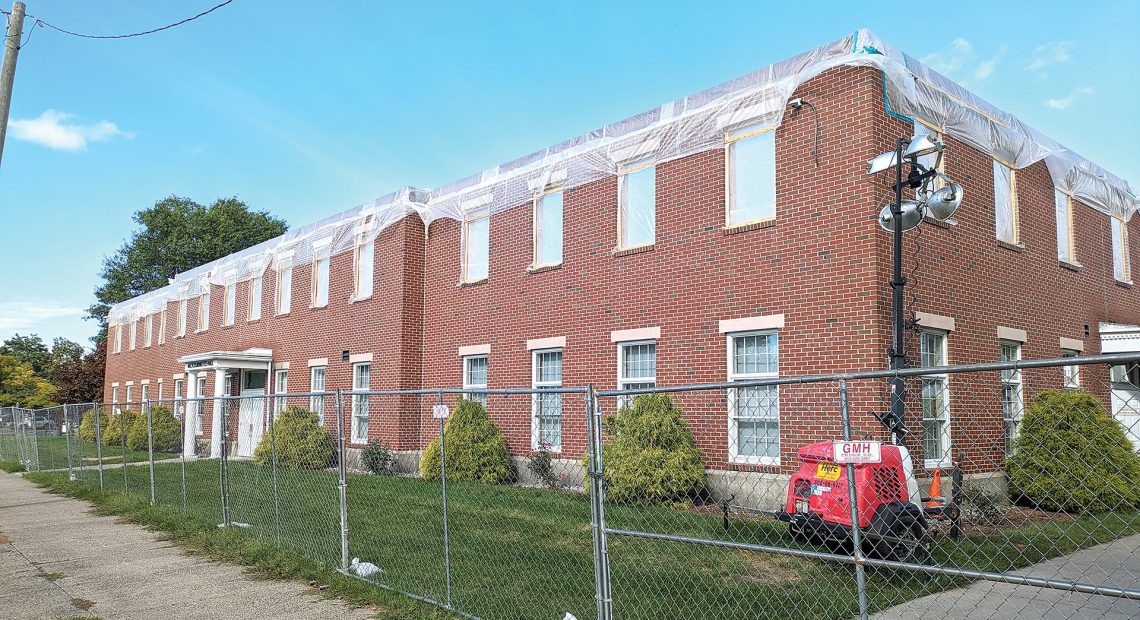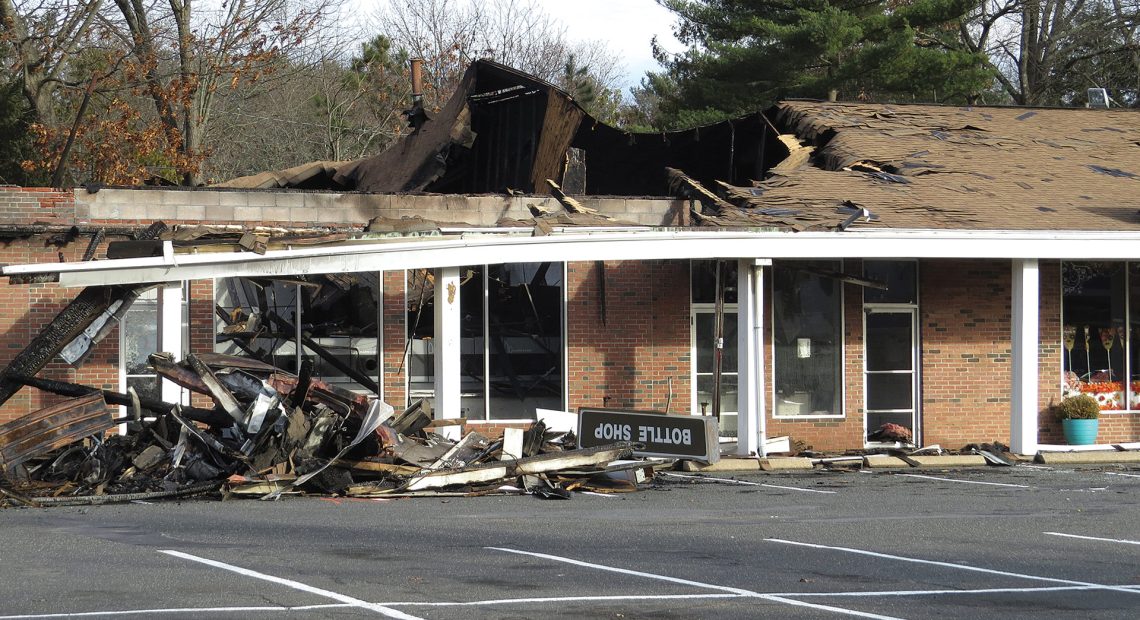After the Fire

The top of Courniotes Hall is covered with plastic now while AIC leaders discuss both short-term winter preparations and a long-term strategy for the building.
When a lightning strike set fire to Courniotes Hall at American International College (AIC) on July 27, the safety of everyone in the building was the paramount concern; fortunately, no one was hurt.
The longer-term concern is for the future of the heavily damaged building, and that process has only begun.
In between was one key question: what to do with all the health programs based at Courniotes and all the students and faculty who typically work and learn there — and do it before the fall semester, which was only a few weeks away.
That process has not been easy, and it’s far from over, said Karen Rousseau, dean of the School of Health Sciences at AIC. But with no programs or classes curtailed (though many have been relocated), the experience has been a valuable lesson in pivoting — and may pose opportunities to “reimagine” the design of the building once it’s repaired and renovated.
“The night of the fire was pretty devastating, but immediately the next morning, we got to work trying to figure out where to put classes that were housed in that building and how we would function,” Rousseau told BusinessWest, listing challenges from replacing the nursing program’s simulation-lab equipment to relocating cadavers and identifying new space for physical and occupational therapy labs and a large number of classrooms.
Part of the solution was finding temporary space in the Colaccino Center for Health Sciences, across State Street from Courniotes Hall, as well as other buildings on campus. Meanwhile, most of the nearby colleges and universities (and some from across Massachusetts) reached out offering space.
AIC took up one offer: from UMass Medical School – Baystate, located in Tower Square in downtown Springfield, which offered not only classroom and faculty space, but also storage for equipment and free parking for students.
“The night of the fire, we had students come to watch it, and they were concerned and sad. But we said, ‘we’re going to make sure it’s business as usual. We don’t know what it is right now, but we will make sure it’s OK for you.”
“UMass fortunately had this space that they weren’t using a tremendous amount; they use it for their accelerated baccalaureate program, but they’re mostly out on clinical placement in the fall,” Rousseau said. “So it was serendipitous that we were able to work around their schedule; primarily, it’s our junior nursing class that needed labs in the fall.”
AIC also quickly rehabbed the basement of its Amaron Hall to use as classrooms and storage for occupational therapy and physical therapy, and it will begin renovating the Lissa Building, which is attached to Courniotes Hall and also sustained damage in the fire, with the goal of opening it to students this spring; meanwhile, a building next to Lissa will be renovated to become an occupational therapy lab and training room where OT students learn how to work with patients on activities of daily living.
In short, the entire health sciences curriculum felt the weight of the fire and its aftermath, but AIC’s leaders made sure all students were able to continue their education this fall.
“I don’t want to make it sound like it was easy,” Rousseau said. “And it’s not all perfect, but it’s good. I mean, the students are receiving their education, and the faculty are happy they all have their own offices. To be able to say that, when we lost all those offices, is a miracle. And a lot of equipment from the labs had to be replaced.”

Karen Rousseau says it hasn’t been easy, but students have been able to continue their studies following the July 27 fire.
They got creative, Rousseau added, because … well, because they had to.
“All of our [health sciences] students flowed through there. The majority nof the faculty for physical therapy was over there, and occupational therapy, and all of the nursing faculty. So all the nursing, PT, and OT students walked through there all the time. A lot of people were affected.”
No Interruptions
The reason AIC had to act quickly, and the reason so many other institutions reached out, was a shared feeling that interrupting the students’ education was unthinkable.
“This was devastating to the students,” Rousseau said. “The night of the fire, we had students come to watch it, and they were concerned and sad. But we said, ‘we’re going to make sure it’s business as usual. We don’t know what it is right now, but we will make sure it’s OK for you.’ That’s what we keep telling students: ‘it’s been OK, and it’ll continue to be OK. It will get better and better as we have more time to roll out our plans.’ But they were really nervous.”
In the longer term, AIC has engaged the services of an experienced project manager to navigate the logistics of assessment and reconstruction of Courniotes Hall.
“We haven’t had a final ruling from insurance, but it’s sounding like we will renovate and restore, maybe not in the same exact configuration, but within that same footprint — but, again, that’s not official,” Rousseau said, noting that the top of Courniotes is now covered in plastic, but some kind of temporary roof will likely need to be erected before winter sets in.
AIC’s much-discussed strategic plan for 2022-27 is called “AIC Reimagined,” and AIC President Hubert Benitez has taken to calling the future of the fire-damaged structure “Courniotes Reimagined,” sensing an opportunity to determine if the building’s current design and layout best serve students and faculty, and making changes as needed.
“He wants to pull faculty together and plan what would be appropriate for the future for that building and whether that means more space, whether we’d look to expand, and address any needs we might have,” Rousseau said. “This was OK when it was built in the ’90s, but if we had to rebuild it, we wouldn’t build it the same way. So, what would it look like? Do we want to replace it exactly the same, or do we need to make some changes? This is an opportunity. You can always use more space than what you had.”
AIC leaders are seeking engagement from students and faculty about what the building should look like for the future, she said, but stressed that the long-term planning process has only begun.
“Our focus right now is on the interim piece for the nursing lab and the occupational therapy lab; that has to come first because we want to get our students back on campus as soon as we can — hopefully for spring. We need more space for OT than what we have right now. We’re making do right now, but we need more.
“And then, with nursing, we don’t want them to have to go downtown to do their simulation and their nursing-practice skills,” she added. “And that is a bigger need in the spring for students. There are a lot more students that have to go through the lab in the spring. It’s important to us that they’re back home.”
This unusual year in AIC’s health sciences programs comes at a time when the medical world is still experiencing staffing shortages in many fields, particularly nursing, Rousseau said, but colleges nationwide have weathered a dip in enrollments in those programs.
“But enrollment across colleges in general is down for all professions, so I think it’s a symptom of the times,” she added. “A lot of people are worried about college debt, and you can go to work right away and still make an OK living wage because unemployment has been so low. There’s also the fact that we’re at that cliff where the birth rate has dropped off, so we’ve just got less people coming out of high school.”
And while nursing opportunities are still soaring — the profession has seen many older entrants who are changing careers to take advantage — there’s also lingering burnout from the pandemic, she added.
“You heard a lot of negativity around anything in healthcare. So I think that’s impacted healthcare. But it’s starting to rebound again — because then people heard about how much travel nurses make.”
Grit and Gratitude
Benitez recently expressed gratitude for the outpouring of support from the community following the fire. “I want to acknowledge the remarkable resilience and unity displayed by our faculty, staff, and students. It is this collective effort from our community that gives me confidence that we will overcome this adversity together.”
Rousseau agreed. “We wanted to reassure our students that we’re still open for business. We’re going to figure it out. And we’re trying to listen to them when there are issues.
“There are some things we can’t control, you know,” she added. “They don’t really want to be in class in a different building and not having their usual space. And the nursing faculty are farther across campus. The biggest struggle is that we’ve lost a large parking lot, so we’ve got some growing pains around figuring that out, making sure it’s OK before we start having snowbanks to deal with, too.”
But all those issues pale in comparion to the main one: ensuring that life continues at AIC, and so do the college careers of its nursing, PT, and OT students.
“We’ve tried to be thoughtful, to make sure this had the least amount of impact on students,” Rousseau said. “We’ve tried to reassure students that AIC is still here, and that we’re an equal partner in their success.”







